
Learn the PPC basics you need to get started with paid advertising.
Pay-per-Click advertising is a popular digital marketing strategy that can bring a lot of benefits to a business.
While there is a lot your organization can gain from executing successful PPC ad campaigns, there is a lot it can lose along the way.
Running PPC ads can be cumbersome, expensive, and downright confusing.
However, the key to making PPC marketing work for you is to have at the minimum, a basic understanding of the different advertising models, and how these work.
To help you get started, we have created this ultimate guide to PPC advertising. As you read along, we hope it will give you the fundamental knowledge you need to start creating effective paid ads.
Pay-Per-Click (PPC) advertising, also known as paid media, is one of the most widely used advertising models in digital marketing. In 2019, PPC was the fifth most common marketing tactic used, with 48% of marketers from B2B companies using it.
The great thing about PPC ads is they get your business in front of people when they’re searching for what you offer or when they’ve engaged with other brands like yours.
They mainly provide a ground for companies to actively and consistently stay on consumers’ radar.
Pay-per-click, like any form of advertising, is about understanding what your prospective customers want and using this knowledge to create high-quality ads that provide insight into the fact that your business offers what they want and need.
It’s safe to say PPC is an incredibly broad topic that can overwhelm many who are unfamiliar with it. When looking to scale your business, it is crucial to have a clear understanding or at least a solid foundation of what PPC is and how it works.
In the following chapters, we’ll walk you through all the PPC basics you need to know to get started with paid traffic.
PPC marketing is an online advertising model used to increase brand awareness and revenue beyond what you generate organically.
Businesses achieve brand awareness by driving site traffic. Site traffic is one of the metrics that gives businesses insight into the number of visits their website receives. More visits to your site mean your brand is getting attention, and consumers are interested in what you have to say.
Aside from garnering more website visits, PPC marketing drives higher conversion rates than organic traffic alone, which can lead to increased sales and more profits. PPC has proven so successful for businesses that it brings in 50% more conversions than organic advertising through search results or social media.
At its core, PPC advertising fulfills three specific goals:
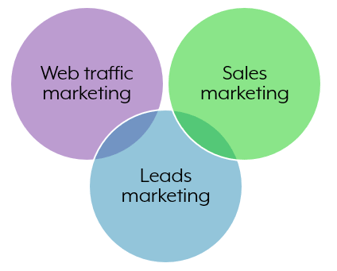
Just like everything in sales and marketing (smarketing), PPC works in a specific manner.
Essentially, a business places an ad or series of ads on a PPC platform (i.e., Google Ads, Facebook Ads, AdRoll, among others), and the company pays a fee every time their ad receives a click. For this reason, we can say that the cost model for PPC ads is CPC (cost per click)The fee an advertiser pays for each click an ad receives in a PPC marketing campaign.
It’s important to note that the fee an advertiser pays will depend on many factors. For example, the cost per click of a paid search ad depends on the keywords it targets, the time of day, and a user’s location.
The cost per click of a social media ad will depend on the social media platform used, the ad quality, and the level of engagement other ads have received.
To measure how effective a PPC campaign is, marketers, evaluate it using the CTR metric (click-through rate) and CPA metric (cost per acquisition). Both metrics are critical but paint a very different picture.
ECPC (enhanced cost per click)A bid adjustment tool that automatically adjusts the maximum CPC bid based on how likely a user is to convert to an ad. is a bid adjustmentAn increase or decrease in the bid amount a business is willing to pay per click on an ad. This figure is calculated as a percentage. Bid adjustments are used to finetune an ad campaign. model that automatically increases or decreases an advertiser’s maximum bid. To do this, Google Ads considers factors such as keyword search volume and competition, a user’s demographics and location, as well as the time of day and the web browser in use, to determine if a prospect is likely to click on an ad and convert.
The goal of ECPC is to help businesses spend their ad budget, where they’re most likely to experience higher conversions.
It’s safe to say that when executed correctly, PPC ads have the potential to present your brand to a broader audience and increase your customer base over a marketing campaign that does not include PPC.
The intent behind pay-per-click is to get the person viewing an ad to click on it, visit the advertiser’s website, and complete the desired action. This action can range from signing up for an email list or purchasing a product. While a business can’t predict the steps users will take regarding their ad, they can incentivize their audience by including a CTA (call-to-action) and designing the customer journey through the ad to promote the desired action.
At its core, these ads provide a way for businesses to buy traffic to their website or app, instead of having users only visit it organically as it happens when a user clicks on a Google search result. This action is especially valuable if you are not currently ranking on page one of Google.
Paid media can be used in all stages of the customer journey (awareness, consideration, and decision), and is a great tool to help prospects progress down this journey. Here are three ways to achieve this:
Since the end goal of all advertising is to encourage users to buy a particular product or service, PPC marketing works best when it targets individuals who seek to purchase these products or services.
Words like “best,” “top,” “affordable,” and “free shipping” are all examples of terms used when shopping online – publishing ads that target these and other similar words can increase the probability of your ad appearing to consumers and receiving clicks.
For small businesses and corporations alike, PPC provides endless opportunities to expand your audience reach.
While relying on SEO tactics, content marketing, and social media marketing are surefire ways to bring in new customers, they take time to build brand authority and the necessary reach to be effective.
With paid media, you only need a solid foundation in PPC, a budget for your marketing campaigns, and the right tools to work with. When you have all three, time is on your side to build a good stream of leads.
What’s more, Pay-Per-Click advertising works for businesses and consumers. Companies can increase visits to their website and their conversion rates while ads guide consumers; they probably did not know to offer the things they’re interested in or need. This fact applies to every type of PPC advertising: search engine marketing, social media advertising, display advertising, and remarketing.
Furthermore, consumers shown display ads as they surf the web are 155% more likely to be intrigued enough to search for items sold by those brands. This fact is important for all online retailers, online retailer giants like Amazon, and smaller businesses alike.
Not to mention that on average, every $1.60 an organization invests in Google Ads can turn $3 in revenue or return on ad spend (ROAS)An important metric in online advertising used to measure the amount of money a business will receive for every dollar they spend on advertising.. For an organization looking to maximize their return on investment (ROI)The amount of money you get back by investing money., PPC advertising is a great way to do just that.
The method of comparing two versions of a web page or app against each other to determine which one performs better. The goal of A/B testing is to determine which variation garners better conversion results.
It is a series of advertisements that have a single message and aim to read a specific goal, like creating brand awareness.
The text within an ad. The goal of all ad copy is to get the reader to click on an ad.
Every click received can increase conversion rates and profits for the advertiser.
Information found on a text ad such as location details, links to pages on your company site, and business phone number. It includes site link extensions.
One or more ads that share similar targets. Ad groups are used to organize your advertisements into different categories, such as themes or products/services or buyer personas.
The position assigned for an ad on a search results page. Because results pages display an average of two to four search ads, an ad ranked number ten will not be displayed at all.
A figure that tracks the average dollar amount spent every time a customer order a product on a website or app.
An increase or decrease in the bid amount a business is willing to pay per click on an ad. This figure is calculated as a percentage. Bid adjustments are used to finetune an ad campaign targeting.
The default match type – it shows ads if a keyword (or any variation including abbreviation, misspellings, or synonyms) is used in a search. It allows for any variation of the keyword(s) to appear.
A strategy that oversees the actions prospects take to complete a specific goal such as signing up for an email newsletter or contacting a business.
The fee an advertiser pays for each click an ad receives in a PPC marketing campaign.
CPM refers to the cost of displaying an ad one thousand times or /one thousand impressions.
An advertising strategy that uses banner and video ads to improve online visibility and conversion rates.
Display advertising is a great way to put your product and company in front of potential customers, think about it like having a storefront with products in the window.
A Google Ads feature that allows businesses to personalize their ads to users’ search queries.
A bid adjustment tool that automatically adjusts the maximum CPC bid based on how likely a user is to convert to an ad.
This match type allows your ads to show only when a user searches for the same keywords. It may include close variations of your keyword, synonyms, or misspellings.
A marketing strategy that implies excluding users who have previously converted into a lead or paying customer from seeing your ads.
A digital marketer who has completed the Google Ads Certification and is well-versed in the Google Ads tool.
A metric used to determine a business’s financial health. It reveals the amount of money left over from sales after subtracting the cost of goods sold.
An impression refers to each time an ad is displayed on a search results page or any other site in the Google Search Network.
The purpose behind a search query.
Parameters that tell Google Ads how selective you want it to be when matching your ads to a user’s keyword searches.
There are five match types: broad match, modified broad match, phrase match, exact match, and negative match.
An SEO strategy that helps marketing teams analyze metrics related to their chosen keywords. These metrics include keyword distribution, keyword competition, and keyword ranking.
The process of searching for keywords relevant to your website and determining which ones can yield the highest ROI.
It also helps in answering: What are people searching for? How many people are searching for it? Where do they search for this information?
Words or phrases used in a search query like “what is DNS.” In PPC, keywords elicit text-based search ads.
The process of matching keywords to what your customers may search for when looking for a product or service.
A single webpage created specifically for a marketing or advertising campaign.
Landing pages are where a user will “land” after they click on a link in an ad and are created at one landing page per one ad.
A marketing strategy that changes depending on a prospect’s geographical location. Marketing tactics adapt to assumptions made of the social, cultural, and personal characteristics of someone based on their location.
The effort to maximize the financial return from the money spent on advertising.
A bid an advertiser sets to determine the highest amount of money they’re willing to pay for a click on their ad.
A match type that prompts your ad to appear only if a search query uses your keyword or close variations of it. Other words between the search terms are allowed.
When creating this match type, each keyword is preceded by a +.
A type of keyword that prevents your ad from showing up when someone searches that phrase.
For example, if a business exclusively sells engineering design services for fabrication, negative keywords they can use are “manufacturing” and “machining.”
This match type will prompt your ad not to show when someone searches for the negative keyword. This match is created by adding a minus sign to the chosen keywords.
For example, if your business repairs Windows and Android devices but not Apple products, using -Apple, -iPhone, or -iPad will indicate Google Ads not to show your ad(s) when a user uses any of these search terms.
A match type that shows your ad only when chosen keywords or close variations of them match a search. There can’t be extra words between the user’s search terms, but additional words can be used before or after the phrase match.
When creating this match type, include your keywords between quotation marks.
For example, using keywords like “red Converse shoes” with a phrase match would yield a user who searches for high-top red Converse sneakers on sale to see your ad.
The process of making a product or service available for use or consumption through direct or indirect means. Defining publications, apps, or other services that directly relate to the product or service you are advertising so that your ads may appear in context with your target demographic.
For example, if you are selling software targeting medical professionals, then it would make sense that your ad appears in a publication that they may read relating to new medical advancements and not an outdoor survival guide.
An online advertising model used to drive traffic to a website. Advertisers pay a fee every time their ad is clicked on.
A score of 1-10 that estimates the quality of your ads, keywords, and landing pages. It acts as a predictor of how effective your ads will be in converting prospects. Google Ads calculates this score.
Remarketing is an advertising strategy that targets individuals who have previously engaged with a business but didn’t buy.
Examples of engagement include visiting a company website, clicking on an ad, or browsing through a product catalog.
An important metric in online advertising used to measure the amount of money a business will receive for every dollar they spend on advertising.
Return on investment is the amount of money you get in return for what you invested.
An online advertising strategy used to increase a website’s visibility and brand awareness. These text-based ads appear search engine results pages (SERPS) after a query is performed.
A marketing tactic used to continue an advertising storyline. Ads are displayed in a predetermined order to match a prospect’s engagement journey with a brand.
A tool used to manage ads on Google Ads. Site link extensions take people to specific pages on your website.
Social media advertising is the strategy of promoting brands on social networking channels.
A specific group of customers for which a publication, an ad, or a marketing campaign is intended.
A marketing strategy that means segmenting your audience into specific groups of consumers.
You can segment your audience into various categories based on demographics, interests, or the amount of engagement they’ve had with your brand.
A type of ad used in search engine marketing to advertise a brand, its products, or its services.
When creating ads to display to potential customers, you need to choose the best PPC platforms. The best platform(s) for you will largely depend on where your target audience goes to look for information and where they spend their time.
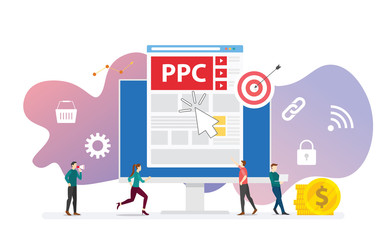
We don’t search, we Google!
With 70,000 search queries performed per second on the search engine giant, if you want to gain new customers, Google Ads is where to go.
With Google Ads, a platform to create search and display ads, it’s now easier to start designing your campaigns. Your search ads will promote your business, help sell the products and services you offer, increase your brand awareness, and boost your site traffic.
It couples a bidding system, keyword auction, algorithms, and metrics such as ad rankThe position assigned for an ad on a search results page. Because results pages display an average of two to four search ads, an ad ranked number ten will not be displayed at all. and quality scoreA score of 1-10 that estimates the quality of your ads, keywords, and landing pages. It acts as a predictor of how effective your ads will be in converting prospects. Google Ads calculates this score. to determine who will see your ads when.
For more significant results, businesses can choose to target keywords using four different keyword match types: broad matchThe default match type – it shows ads if a keyword (or any variation including abbreviation, misspellings, or synonyms) is used in a search. It allows for any variation of the keyword(s) to appear., modified broad matchA match type that prompts your ad to appear only if a search query uses your keyword or close variations of it. Other words between the search terms are allowed., phrase matchA match type that shows your ad only when chosen keywords or close variations of them match a search. There can not be extra words between the user’s search terms, but additional words can be used before or after the phrase match., and exact matchThis match type allows your ads to show only when a user searches for the same keywords. It may include close variations of your keyword, synonyms, or misspellings..
Digital marketers who are interested in learning the ropes of Google Ads can complete the Google Ads certification program. Upon completion, you can use your new skills to create successful and profitable ad campaigns as a Google Advertising ProfessionalA digital marketer who has completed the Google Ads Certification and is well-versed in the Google Ads tool..
LinkedIn is a networking tool for industry professionals where they can network with other professionals they may know, build connections, and have references to rely on when encountered with a work-related issue. LinkedIn is a breeding ground for new leads; 80% of all B2B leads come from LinkedIn.
LinkedIn Ads is different from other social media/networking PPC platforms because it caters to individuals when they have a business mindset.
If these people see an ad on social media, they will most likely scroll past business or education-oriented ads. But on LinkedIn, there are 663.3 million individuals that have the potential to help leverage their professional needs.
As the leading social media network, Facebook is fertile ground for any business eager to increase their engagement and conversion rates.
With Facebook Ads, businesses have the potential to reach 2.5 billion active Facebook users. What’s more, many companies have created such successful PPC campaigns using Facebook Ads that the average CPC for an ad is $1.72.
While most individuals see Facebook as a means for social networking, the platform’s algorithms help businesses match their ads to users with a demonstrated interest in their brand or similar brands. This results in a boost in their conversion rates and increases their business revenue.
PPC is an essential component of a business's overall marketing plan, by enabling them to get in front of consumers when they do not have the domain authority to rank organically. PPC allows them to guide the customer experience more than what is possible with organic search sooner.
Unlike other SEO strategies that can take new websites months or even years to see significant results, PPC advertising provides a quicker way to gain visibility online.
You can start crafting an ad campaign with a basic foundation of PPC, a substantial ad budget, and a list of keywords you want to target and the PPC metrics you want to measure.
Many PPC platforms, including the most popular ones for B2B companies, have data systems and algorithms in place that help businesses manage their campaigns and measure their progress, allowing them to maximize their ROI.
When executed correctly, PPC advertising strategies can significantly increase a company's brand awareness by 80%. This typically happens when an individual or a business in the awareness stage of the buyer's journey is experiencing symptoms of a problem. They are researching to understand and give a name to their problem. When they conduct a search query using keywords that describe their problem, Google will display search ads on businesses that could help define and address their issue.
This is true of search engine marketing, display advertising, social media advertising, and sequential advertising. When a consumer sees an ad, they can click on it, head to the business's website, and engage with the brand – something that wouldn't have been possible without the ad.
PPC advertising makes tracking and measuring your campaigns easy and effective.
Armed with a list of metrics you can track, most PPC platforms like Google Ads provide real-time statistics that show how your campaigns are performing, the kind of traffic, and the results that are driving your revenue.
Examples of metrics anyone can measure are:

PPC allows for attribution, which marketers use to track the ad spend that goes to an individual user. It can also measure how much the user has spent on a business, which lets marketing teams fine-tune their ad campaigns. This granularity is one of the most powerful features of PPC advertising. Unlike many other forms of advertising, such as TV or Print, PPC advertising allows you the ability to see what is working very clearly so you can invest in the channels that drive the best results.
PPC platforms provide detailed information for organizations to determine if an ad campaign is exceeding expectations. Access to such information in near real-time allows marketing teams to tweak their keyword strategy is necessary to get the most value out of every dollar spent.
Incorporating PPC into your business strategy provides a surefire way to gain significant control over how much you spend on each campaign and where you allocate the money spent.
With this advertising model, your organization is only responsible for paying the clicks on your ads that result in your desired goal. This kind of website traffic increases the chances that your leads will convert into paying customers.
Unlike other traditional forms of advertising where organizations are required to define a fixed budget for a set duration, PPC advertising allows you to adjust your budget at any point in time. This translates into fixing your budgets daily if you have to and depending on your ad performance.
Beyond that, PPC gives businesses the flexibility to fine-tune whom they target in their campaigns based on their buyer personas. In paid search marketing, the keywords these personas are likely to use when performing a search query.
While seasoned PPC professionals may already know how to distribute their resources for a winning campaign, not every business that uses paid search, social media, display marketing, or remarketing has this skill down.
A significant advantage Pay-per-Click offers is the freedom to continually adjust ad and keyword bidding to adapt to the different advertising budgets and goals a marketing campaign has. It also helps novice businesses to dip their toes and start bidding amounts they are comfortable with until they gradually build up experience to bid on highly competitive keywords successfully.
So how does PPC allow advertisers to adjust their bidding? Let's look at the various methods.
Shared budgets are a Google Ads feature that lets advertisers distribute a daily budget shared between multiple ad campaigns in your account.
This feature gives you greater freedom to match your ad spending with your overall marketing budget and build in better alignment between your campaigns.
Let's say you are running three campaigns:
If your marketing budget allows you to spend $150 a day on advertising, you can choose to evenly distribute your budget among all the campaigns or allocate more money to one campaign over the other based on your preference.
If the desktop search campaign has received poor clicks and lower conversions over the other platforms, you can redistribute your budget differently to improve the results from the devices that are showing better results.
The key is to find a balance that fits your business – you can do these by analyzing key metrics to make well-educated decisions.
Determining how much to invest in advertising can be tricky. You want to avoid overspending on a campaign that will not deliver enough positive results. Underspending is not a good idea either if there's potential to increase your sales. In this case, you may want to consider spending a little more.
To know how much an organization should be spending on PPC, marketing teams need vital information about the lifetime value of the client and the value of a conversion to determine the ad budget. Before creating a campaign budget, the overall financial goals need to be understood, past ad performance has been analyzed, and determine how much the business can afford to invest in the campaign.

Various factors play into calculating the right amount to invest per ad campaign. The key is to strike a balance between your campaign budget and knowing where to focus these efforts. Often, this means setting specific objectives. Here are some common goals for the top PPC intents:
We aim to show our ad to the highest number of people interested in the type of products we sell.
Our goal is to gain 120 new leads over the next two weeks.
Our goal is to get 100 new users to sign up for our email newsletter in the next two weeks.
We want to gain 15 new customers in the next week and pay less than $200 per acquired customer.
HubSpot's Advertising ROI calculator provides a helpful interactive experience for businesses interested in learning how different factors affect their return on ad spend (ROAS)An important metric in online advertising used to measure the amount of money a business will receive for every dollar they spend on advertising. .
With the ad ROI calculator, anyone can adjust the number lines for each element. With every adjustment, the results column on the right-hand side will fluctuate to reflect new results.
The most significant advantage of using this tool is that businesses are only required to know their figures for five different metrics: projected monthly budget, excepted CPC, target conversion rate, average sale price, and lead to customer rate. The interactive calculator does the rest.
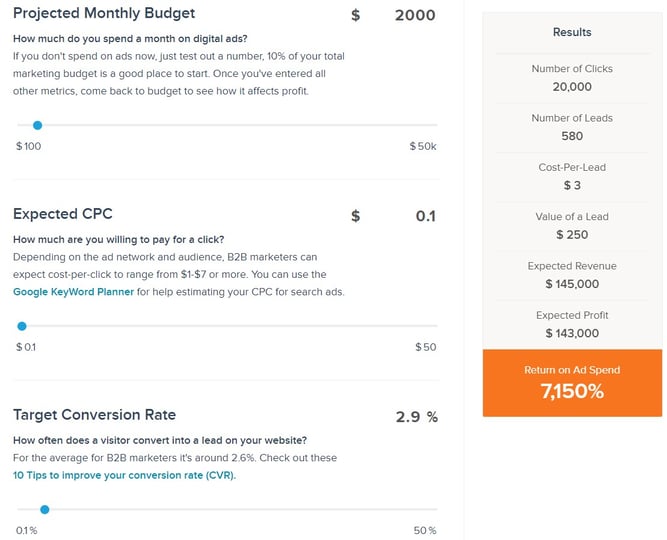
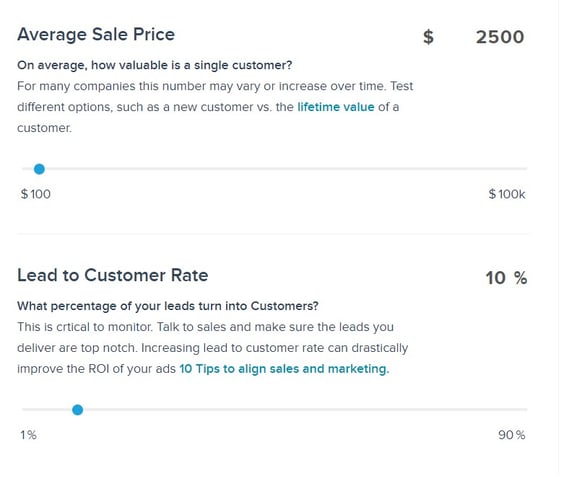
Bid adjustmentsAn increase or decrease in the bid amount a business is willing to pay per click on an ad. This figure is calculated as a percentage. Bid adjustments are used to finetune an ad campaign targeting. give advertisers a choice to show ads as frequently or as less often as they want through a modification of bidding amounts.
For example, specific keywords may bid higher in one location than in another, or clicks from a mobile device may be worth more than on a desktop. The most significant factor influencing bid prices is the bid auction.
A bid adjustment is expressed by a percentage (%), which helps to calculate an advertiser's new maximum bid.
Let's say you have a desktop search campaign that is performing well with a maximum bidA bid an advertiser sets to determine the highest amount of money they’re willing to pay for a click on their ad. of $0.95 per click. If you want to increase your performance, you may want to adjust your maximum bid by 20% for desktop searches. If we place a 20% increase on the $0.95 bid, your new maximum bid is $1.14.

In this case, we adjusted the maximum bid for what Google Ads calls a "device bid adjustment." Likewise, there are various types of bid adjustments that give businesses the freedom to increase their odds of appearing on search queries.
These include:
You can get more information on bid adjustments in Google Support.
Nothing in life is perfect, and neither is PPC advertising.
While many companies that have incorporated PPC into their lead generation efforts can cite its many benefits, some disadvantages are real, especially to those for whom PPC is unfamiliar territory. The following are some downsides to PPC advertising:
Many factors go into understanding PPC advertising – keyword research and bidding, writing ad copy, A/B testingA method of comparing two versions of a web page or app against each other to determine which one performs better. different versions of the same ad, learning which keywords yield the most conversions for your business – the list goes on.
Any business looking to incorporate PPC should learn the ins and outs around its famous bidding system.
For many organizations unfamiliar with it, the bidding system can appear overwhelming. In addition to this, successful keyword bidding may come at a hefty price; businesses compete against each other to be featured the most or look in the top spots.
One of the main factors that affect bidding is your ad's quality scoreA score of 1-10 that estimates the quality of your ads, keywords, and landing pages. It acts as a predictor of how effective your ads will be in converting prospects. Google Ads calculates this score. and how well it matches a searcher's intent.
Keyword intent is a crucial aspect of paid search. Without an understanding of this concept, a business cannot predict the intentions behind a visitor's search query, and their ads will not show up as well as possible.
To avoid overspending your marketing budget, monitoring and optimizing your ad campaigns is a must.
There is not an ad platform in today's online landscape that is entirely invested in providing businesses a maximum ROI. For this reason, organizations have the utmost responsibility to ensure their campaigns are targeting the right keywords and audience.
You can avoid the common pitfall of throwing money on campaigns that do not perform to expectations by brainstorming keywords your target audience is likely to use in the awareness, consideration, and decision stages of the customer journey. Also, take time to perform extensive keyword research, identify the intent behind commonly used keywords, and consider readjusting your PPC ad budgets to reflect your ad's current performance.
Much like other marketing campaigns, PPC ads need considerable time investment to optimize and improve for greater results.
PPC marketing strategies are far from a "set it and forget it" system. Despite ad platforms offering task automation in the form of AI, meant to improve the quality of your campaign and the quantity of data recollected, many of them lack the sophistication and analysis that can be provided by a human.
PPC is not a practice that will drive a high conversion rate within a short period without the right knowledge and experience.
Many organizations choose to work with digital marketing agencies. Businesses hire them to set up their ad campaigns because PPC requires the dominion of particular skills such as copywriting, data analysis, and keyword research.
While PPC platforms are designed to be user friendly, to get the most out of PPC, marketers need time learning the ins and outs of the system and optimizing the campaigns to make them useful.
By nature, PPC requires advertisers to pay a small fee every time their ad receives a click.
Considering every consumer can be placed into one of three stages of the buyer's journey (awareness, consideration, and decision), many users don't perform a search query with the intent to buy.
To decrease the odds of paying for clicks or receiving visits to your site that do not lead to sales, advertisers would do well in targeting keywords and optimizing their ads that cater specifically to each stage of the buyer's journey.
While PPC is considered a singular advertising model, this is not true. There are multiple types of PPC, each with its characteristics and rules to follow. Businesses can incorporate one or a combination of them to construct an ad campaign that can best help achieve their needs.
Search Engine Marketing (SEM) is one of the most effective strategies any online business can use to grow in the ever-changing and competitive online world. It is also one of the most widely used and goes by many names, including paid search advertising, paid search ads, paid advert, PPC An online advertising model used to drive traffic to a website. Advertisers pay a fee every time their ad is clicked on., CPCThe fee an advertiser pays for each click an ad receives in a PPC marketing campaign., and CPM. CPM refers to the cost of displaying an ad one thousand times or /one thousand impressions.
By definition, SEM is an online advertising strategy used to increase a website's visibility and brand awareness. Search engine ads are easily identifiable for their simple headline, text description, URL format, and a small "ad" icon.

As users, we see this kind of PPC ad every time we search for something on Google, Bing, or most other search platforms. Most of the time, people are unaware that the first search result on a SERP is a paid advertisement. Many users are unable to identify a paid ad on a search results page.
Sponsored search ads appear at the top and on the side of a search engine results page (SERP). The position of these paid results is strategic - it is meant to attract a user's attention before they scroll down to the organic search results that characterize SEO. They can also be seen on other Google partner websites like YouTube when users search for the products or services you offer or when actively searching for product review videos.
SEM is different from SEO for one important reason: in SEO, businesses do not pay Google for web traffic and clicks. Instead, they earn their right to get featured in SERPS by having the most relevant and high-quality content for specific keywords.
Important note: optimizing your PPC campaigns to receive optimum results and investing in a strong SEO strategy for your website can increase your chances of organically ranking higher on SERPS for the same keywords that you invest ad spend on.
SEM can help grow your business by driving traffic to your organization's website, traffic that may not have been able to see your business on the organic section of the search results.
Search ads contain three distinct elements that, as a whole, serve to convey a business's message to customers.

In an ad, the first thing anyone ever notices is the headline. Text ads consist of three headlines, each separated by a vertical pipe "|." For better ad results, be sure to include keywords that users may have used in their search.
The display URL is a website's address and will usually appear in green. URLs are shown in text ads to give users an idea of the web page they will be redirected to when they click on the ad.
This section serves to highlight any details or unique characteristics of your product or service and the ideal location to place call-to-actions.
As the most frequently used search engine, Google delivers an average of 5.8 billion searches a day.
Every time a user performs a search query, she uses specific keywordsWords or phrases used in a search query like “what is DNS.” In PPC, keywords elicit text-based search ads. to communicate best what she is looking for. For businesses looking to advertise to these users, it is essential to get the intent behind the keywords used right.
The keywords used will inform Google's algorithm of the information a user seeks and will match all available search ads to their results. The ads chosen are usually those that best provide information for the search and have won Google's bidding marketplace.
A significant advantage of incorporating SEM into your marketing efforts is that a consumer sees your sponsored result only after searching for a relevant keyword (a keyword for which you have placed a bid on).
Therefore, the targeted users who see it have already shown a related interest that's tied with your business objectives. Not only that, but every person who actively searches for something commercial in nature (that is, it can be bought) is already predisposed to making a purchase.
SEM also provides an efficient and cost-effective method for paid advertising – advertisers only pay for every click their ad receives. With every visit, a website gets also means an incremental improvement on its organic search engine ranking provided the person does not leave your page immediately.
Every search query reflects a consumer's need. Whether it is for information, a location, or a product, there is a reason for it.
Just like every search engine user want the search results they get to be relevant to what they want and need, if you want them to click on your ad(s), it will have to be related to what they are looking for, the intent behind the search query.
However, publishing ads with relevancy to popular keywords isn't enough to win at PPC advertising. Having a substantial advertising budget is not either. The reality is that search ads go through a process known as an ad auction before they can appear next to organic search results.
Google Ads' auction considers a variety of factors when determining the final placement of ads shown on SERPS. The three deciding factors are maximum bidA bid an advertiser sets to determine the highest amount of money they’re willing to pay for a click on their ad., quality scoreA score of 1-10 that estimates the quality of your ads, keywords, and landing pages. It acts as a predictor of how effective your ads will be in converting prospects. Google Ads calculates this score., and expected impact for your ad extensions.
Keep the following in mind:
Google calculates these metrics during an ad auction to determine the place of advertisements. After all, it is in their best interest that consumers see only the most qualified ads. Ad rankThe position assigned for an ad on a search results page. Because results pages display an average of two to four search ads, an ad ranked number ten will not be displayed at all. is the result of an ad's maximum bid and quality score.
Maximum bid * quality score = ad rank
When it comes to showing up as a sponsored result on SERPS, ad rank is king. The goal for every search ad should be to place within the first two to four ad spots, above the organic search results. In some cases, it may be better for your ad to rank in a position 4 – 7 (advertisements that show up at the bottom of the page). Doing so helps advertisers pay a much lower bid amount and allows them to pick up any traffic that does not find what they are looking for in the organic SERP section.
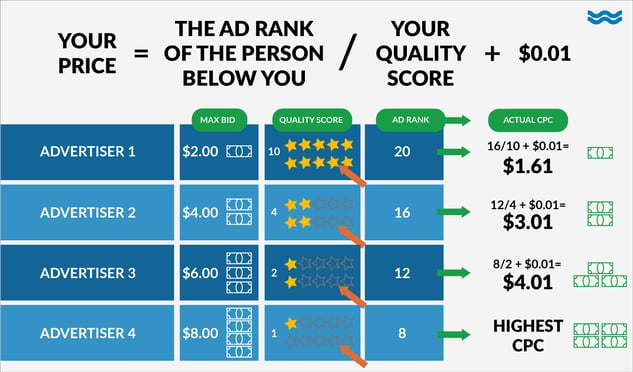 (Source: Wordstream)
(Source: Wordstream)
Part of understanding how PPC bids are calculated is knowing that bids are a necessary component of PPC. Bids influence how visible your ads are and the amount of engagement you receive from them at any given time.
If your bidding game is not on point, you may miss out on much-needed conversions. With PPC advertising, businesses place bids on the keywords they want to target. These keywords will influence the maximum bid they're willing to pay for every click their ad receives.
Google's quality score is a diagnostic tool that helps measure the quality of your ads and the keywords you use. It considers:
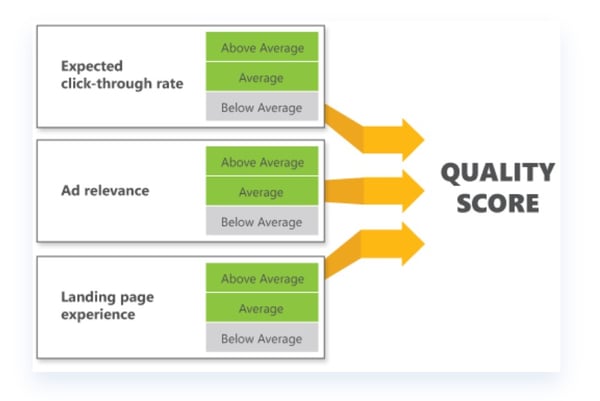 (Source: Instapage)
(Source: Instapage)
Google has not disclosed the weight each factor carries in determining your ad's overall quality score. However, the most significant factor is your CTR – it demonstrates how effective your ads have been in attracting users.
Google Ads Quality Score is not a key performance indicator. Its diagnostic report evaluates three crucial areas of ad quality: ad relevance expected CTR, and landing page experience. It is meant to highlight the areas where you can improve your ad quality.
Display advertising is a strategy that uses banner and video ads to increase online visibility and conversion rates.
If you have ever visited a website and seen banner ads with colored text, images, animations, or videos, then you've seen a display ad. Their flashy appearance is meant to encourage site visitors to take a specific action like click on the ad or take notice of a tempting offer.
Display advertising can be seen in action after a user googles a keyword string such as "payroll software" and subsequently sees an array of ads on payroll software on the different websites they visit afterward. Also, these ads can target specific audiences based on various demographics, topics of interest, or placementThe process of making a product or service available for use or consumption through direct or indirect means. factors.
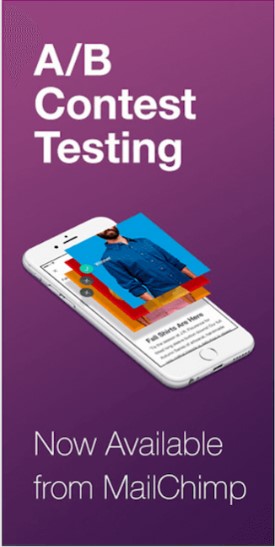 (Source: Bannersnack Blog)
(Source: Bannersnack Blog)
The broad reach of display advertising makes it a great tool to build brand awareness because you can show your ads to people that have shown interest in products similar to yours but otherwise may have never heard of your product.
Display ads are a powerful tool to invest in because they have the potential to reach a vast majority of the Internet.
Just like search ads can be managed through the Google Ads platform, displays ad management takes place on the Google Display Network.
The Google Display Network (GDN) is a segmentation of Google Ads that allows advertisers to reach their audience in the right places, that is, on other sites they may be visiting on the web.
GDN works like this: They bundle sites, they segment by categories based on industry and niche (think music-related websites and apps or those within the health & wellness industry) and offer them to advertisers as a package.
These bundled sites are created into ad networks that receive bids from businesses advertising – those that bid the highest earn space on the websites of their choice. Similar to search ads, an advertiser pays by way of CPC; for video ads, advertisers only pay when a user chooses to watch their ad. A business also can have its ads paid for based on the number of people that have seen the ad, CPM.
The GDN is a powerful ally for businesses. It helps with audience reach, keeping ad spend affordable, and providing many options for organizations to customize their audience targeting.
It works by:
Display ad targeting can be one of two ways:
There are three different objectives that a display ad can have:
Retargeting display campaigns are often used for remarketing to prospects who previously interacted with a business but failed to purchase at the time. Learn more about remarketing display campaigns here.
Acquisition ads aim to bring advertisers more sales. These are usually followed by a special offer, a holiday promotion, or an attractive discount.
The rise of ad blockers can make running acquisition ad campaigns a bit tricky. While third-party sites can encourage users to turn ad blockers off, it is entirely up to the user to follow through with this suggestion. However, when done correctly, they can generate satisfactory results.
Ad blockers aside, one way that acquisition ads can generate positive results is by creating display ads that target customers across the buyer's journey.
For example, an acquisition ad that targets those in the decision stage will likely offer an attractive discount to prospects who have previously interacted with the business. Any type of interaction with a brand such as following its social media profiles, visiting its website, or receiving its email newsletters are all forms of engagement.
Brand awareness aims to reach the highest number of relevant users possible and get them interested in the brand. They differ from their retargeting and acquisition counterparts because they don't necessarily want a consumer to take any type of action besides remembering their brand.
The key to succeeding in brand awareness campaigns is to segment your audience, much like you would with acquisition campaigns. Still, instead of considering sales, conversion ratesA strategy that oversees the actions prospects take to complete a specific goal such as signing up for an email newsletter or contacting a business., and return on ad spend (ROAS)An important metric in online advertising used to measure the amount of money a business will receive for every dollar they spend on advertising., your focus is on measuring the number of impressionsAn impression refers to each time an ad is displayed on a search results page or any other site in the Google Search Network. and clicks. This is one of the most powerful ways to use display ads as they typically have lower than the average click-through rates, at 0.35%.
Every business needs to use social media in their favor if it hopes to achieve any kind of success in today's online marketplace.
Social media advertising is the advertising strategy of promoting brands on social networking channels. It has the power to drive prospects, boost a business's revenue, and exponentially increase brand awareness.
Investing in paid social efforts for your business brand is a sure way to educate audiences on the products and services you offer. 52% of brand discovery happens in social feeds, and 27% of users discover new products through paid social ads.
Social media ads allow businesses to evaluate how users interact with their brands. Whether their ad is clicked on, receives a comment, or if the brand receives a direct message asking for more information. Other distinct advantages to using social media advertising include the possibility of:
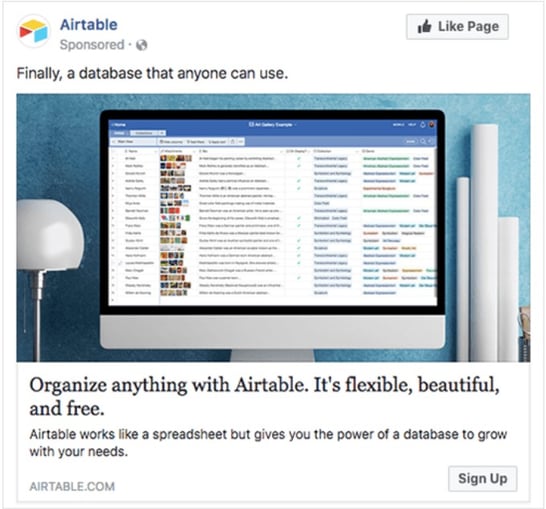 (Source: Leadfeeder)
(Source: Leadfeeder)
Creating and optimizing your organization's social advertising strategy can bring in significant ROI to your business; this will depend on the nature of your business and the social platform you're working with. For example, B2B companies gain more qualified leads on LinkedIn than other social media networks. They should steer clear from Instagram and Facebook unless they have evidence that advertising on these sites could pay off.
While not every business should advertise on social media (i.e., divorce lawyers or funeral homes), most business types have enormous potential when they invest in social media advertising.
With the rise of social media advertising, now more than ever, marketers are spending more on their paid social efforts. In 2019, they invested more than 89 billion dollars. It is estimated that in 2020 alone, social media ad spending will increase by 8.7% and reach $102 billion.
It comes as no surprise every social media network – popular or not – now offers businesses the option to advertise on their platforms.
Choosing where to advertise can be tricky, but you should focus on where your audience likes to be. Just as complicated as deciding where to put your ads is which type of ads you should use.
For our audience, we will focus on Facebook and LinkedIn ads.
Facebooks photo and video ads work to promote a product or service and, by default, are structured to tackle all stages of the buyer's journey.
They are best employed when used in the following cases:
To remarket to prospects who abandon their shopping cart
Remarketing to prospects who abandon their shopping cart works by using ad copy to remind users they were in the middle of adding items to their shopping cart on the business's website.
To increase their product trials
Most businesses add vibrant images or short, featured videos to their Facebook ads to pique a prospect's interest. Once the prospect has an idea of how the product – be it a subscription service or business software – works and how it can add to their wellbeing, they are offered a free trial to try it out for themselves.
Emphasize brand authority
Take Netflix, for example. Let's say a user is currently using the streaming service for a month's trial period. Ideally, once the trial is over, the user will continue their use and become a paying customer. To get them to take the next step, Netflix can advertise on Facebook and emphasize the service's popularity and affordability.
Reveal a flash sale
Advertising wouldn't be the same without ads promoting flash sales. A Facebook user who interacted with a brand, signed up to its email list, or bought an item from their website, is an ideal candidate for this type of ad.
Advertise a lead magnet
Businesses often use Facebook Ads to advertise the lead magnets otherwise found on a landing page. This is a powerful tactic that, when coupled with the right image and compelling ad copy, can lead to more email subscribers.
Facebook photo ads work well for highlighting new products or services. Video ads help to showcase how to use a product such as a software program.
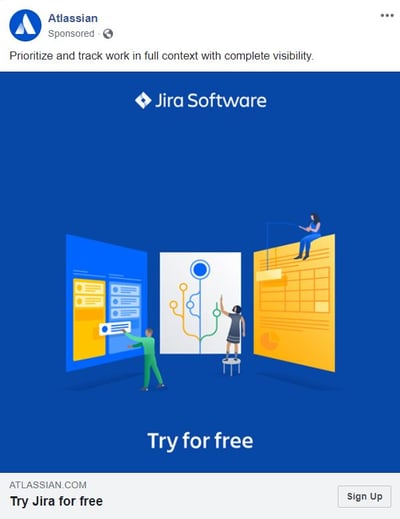
Messenger ads are photo Facebook ads placed on the home screen of the Messenger app. You can use them to encourage people to connect with your business on Messenger, but they can also link to your site.

LinkedIn's ads work to promote a product or service and, by default, are structured to tackle all stages of the buyer's journey.
LinkedIn Ads are often employed for the following use cases:
To generate brand awareness
Businesses can leverage their content marketing efforts by using ads to promote their content, their LinkedIn profile, and their brand. Advertisements that promote an engaging piece of content (generally a lead magnet) are often more successful in persuading prospects to click on it and read the content.
To promote an event
B2B companies must put in some work to promote any large-scale in-person or virtual event they will be hosting. Ads that fall within this category often link to a page where prospects can sign up to attend.
Sponsored content ads are found under a user's news feed and, like Facebook, encourage engagement through likes and comments.
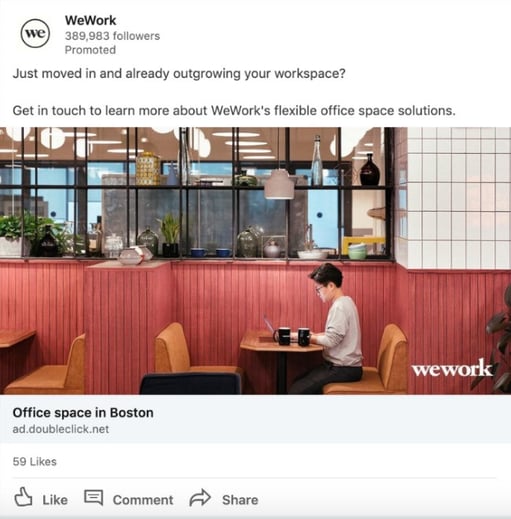 (Source: HubSpot)
(Source: HubSpot)
InMail is LinkedIn's version of private messages. These ads target users who have interacted with a similar business and appear only when they are online.
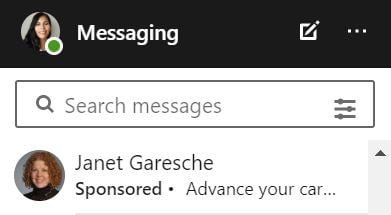
Similar to Google's search ads in their structure, LinkedIn text ads keep things simple by focusing on a catchy headline, ad description, and allows for a thumbnail image of 50 x 50 pixels.
While every few years, we see new social media networks emerging, Facebook remains the king. With 1.62 billion users on the site daily, this is a perfect platform for businesses to advertise.
As a company investing time and a portion of their marketing budget to advertise on Facebook, how do they know their ads will be shown to the right audience?
Facebook Ads and LinkedIn ads in tandem with their respective social networks, use specific criteria to determine who sees what while scrolling through their news feed.
As we can see, these social platforms track every activity a user has on its platform.
What's striking is that it also has access to the websites and apps you visit outside of its sphere of influence known as "off-Facebook activity." How it works: Facebook learns this information from advertising partnerships with third-party apps and websites, which voluntarily tell Facebook the identities of people who visit them.
Today, over 6 million businesses advertise on Facebook Ads. There is much competition – businesses are competing with each other to be featured on their target audience's news feed.
So how does budgeting work? And how does Facebook Ads determine which ads are seen?
For starters, businesses have a set daily budget. They can choose to adjust it based on their ad performance.
Similar to what happens with search ads, those on Facebook have to go through an ad auction.
Ad auctions take place every time Facebook sees an opportunity to show a user an ad based on their activity. From there, every ad that targets a specific audience (based on gender, location, age, among others) will compete in the auction. The winner of the auction is determined by calculating the total value of the following criteria:
As we can see, the approach is very similar to Google Ads' bid auction.
Much like Facebook Ads, LinkedIn Ads decide which advertisement is displayed to users based on auction results.
Bidding functions as a second-priced auction, winning ads only pay the minimum amount needed to best the second-highest bidder.
An auction winner is determined based on the highest bid + past ad performance.
Both paid search ads and Facebook Ads follow the CPC payment model. That is, an advertiser pays for an ad each time it receives a click. LinkedIn Ads are a little different. Advertisers on LinkedIn can choose to pay for their ads using the CPC or the CPM payment model. In CPM, businesses pay for every 1,000 impressions their ads receive.
Remarketing is an advertising strategy that targets consumers who previously interacted with a business but did not buy. Common examples of engagement include visiting a company website, clicking on an ad, or browsing through an online product catalog.
It is a powerful direct response tactic that maximizes ad ROI. What's more, it exclusively targets and serves ads only to those individuals who've previously interacted with your brand or have been a customer.
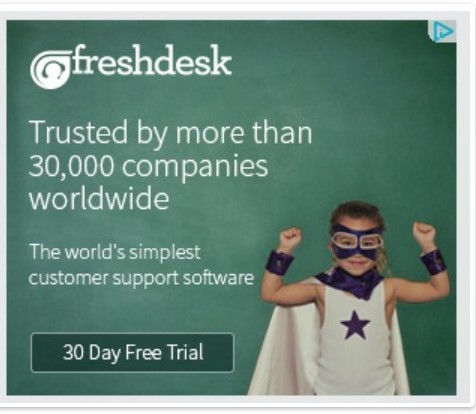 (Source: Wishpond)
(Source: Wishpond)
Remarketing follows a six-step process:
Most remarketing ad campaigns are managed through the Google Ads, Facebook Ads, LinkedIn Ads, and AdRoll platforms.
On desktop devices, remarketing ad campaigns can target users through the use of tracking tags and cookies.
Tracking tags are an anonymous cookie that attaches to the web browser of every visitor who visits your website. From there, the tracking tag can, as the name goes, track every visitor and segment users based on their browsing behavior.
Each segmented audience is targeted through ads placed on websites that directly or indirectly relate to your business, its products, or services offered.
Companies can also upload an email list of their subscribers for remarketing.
On mobile devices, remarketing efforts use these elements to track and display their ads:
Platforms also use probabilistic matching and deterministic matching to choose the ads users see.
Probabilistic matching uses a data technique that makes an educated guess on a user's identity. It uses algorithms to piece together a character based on thousands of anonymous data points, such as those specified above.
Deterministic matching uses a user ID's (Facebook, Instagram, LinkedIn, and Twitter accounts and email address) and device IDs such as Apple Advertising Identifier (IDFA) and Google Advertising.
Prospect remarketing on a business website is pretty straightforward from a user's perspective. When they click on a retargeted ad and land on a company's page, they typically see a landing page that prompts them to download a lead magnet in exchange for their email address or an ad that offers a discount offer.
As a business, your retargeting efforts can consist of displaying your advertisements to users who:
As an advertiser, you have two options: to retarget a prospect on your site in a similar situation like the one above, or you can segment your audience and reach them on Google affiliate websites or social media.
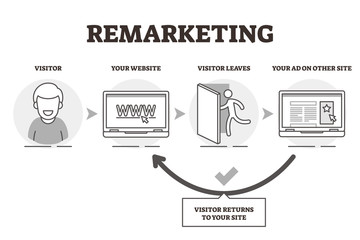
Remarketing on search engines translates into using search ads to reengage users to a brand, which typically includes adding previous site visitors to a retargeting list. Each time they research any keyword(s)that you've placed a bid on and your ad manages to rank high enough to be featured on a SERP, users will have another chance to click on it.
There are two principal strategies you can use to retarget effectively:
Remarketing to users on social media takes a similar approach.
After someone visits your website but fails to convert, most remarketing ads on social media can track a user's activity through special cookies.
Most social networks, like Facebook and Instagram, have a cutthroat approach to remarketing. After an individual has interacted on a site by browsing certain products, adding these to a shopping cart, or purchasing, your retargeting partner will drop a virtual cookie to report this action.
This cookie lets PPC platforms like Facebook and Instagram know to remarket to the user by displaying your brand's ad(s) in their newsfeed. While this practice can increase conversion rates, businesses need to create various ads because click-through-rates can decrease by 50% after running the same ads for an average of five months.
While SEM can come at a hefty price, ads featured within the top sponsored results act as a gateway for Internet users to learn about a business and possibly become a lead.
Therefore, creating successful SEM ads is just as important as knowing how to measure its effectiveness.
There are some things you can integrate into your ad campaigns to improve your conversion rates, includingconversion trackingA strategy that oversees the actions prospects take to complete a specific goal such as signing up for an email newsletter or contacting a business..
Ad extensions are all about giving consumers a little more information about your business without clicking on your ad. This can work both ways: it can dissuade someone from not clicking on your ad. For example, if your business is a few hours away, they’re probably not going to want to go to your physical location. Situations like this are a good thing – you only want to pay for clicks that are likely to turn into customers!
Ad extensions can also persuade others to click on your ad because they make your ad visible. They stand out from search ads on the SERP.
Extensions like site link extensionA tool used to manage ads on Google Ads. Site link extensions take people to specific pages on your website., call extension, message extension, and location extensions all work together to get you more qualified visitors to your site.
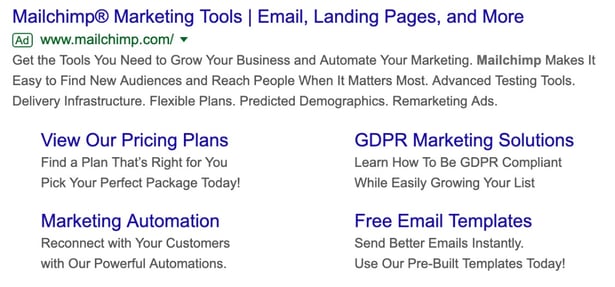
Making your ads work usually comes down to being very specific about who sees them. PPC marketing is all about driving quality traffic to your site.
With methods like targeting, exclusion, and location-based marketing, you control the audience that can access your ads based on who is more likely to make a purchase.
If you are aiming to increase your conversion rate, you will need to dig a little deeper and determine how many of those website visitors made a purchase.
Now, because customers usually perform multiple searches and may click on different ads before they commit to buying something, advertisers find it difficult to determine which keywords or which ad(s) are primarily responsible for persuading a customer to buy.
Attribution models give advertisers a better understanding of how your ads are performing and how you can optimize them for better conversion results.
HubSpot’s attribution reports are a set of reports that show the factors that are influencing your customers across the buyer’s journey. The information provided is vital to your continued success because it lets businesses reach customers earlier in the buyer’s journey and improve their keyword bidding.
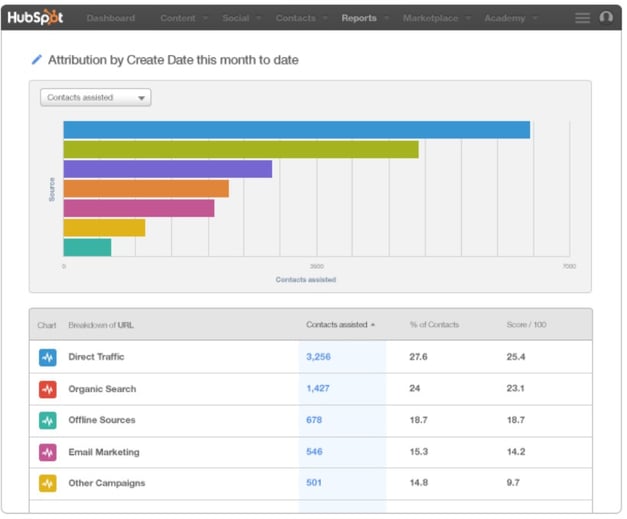 (Source: HubSpot)
(Source: HubSpot)
There is a difference between SEO keyword research and PPC keyword research. The difference lies in the keyword intent and what you want to do with these keywords.
In SEO keyword research, a marketer is looking for the best keywords their audience is likely to use for informational purposes, usually with a low intent to buy. What an SEO professional wants is to get their content out on the web so anyone – regardless of whether they want to buy or not can read them.
In PPC keyword research, there is every intention to get users to buy. For this reason, PPC professionals choose to target keywords with a high intent to make purchases. After all, businesses can't afford to spend money on clicks that won't lead to sales.
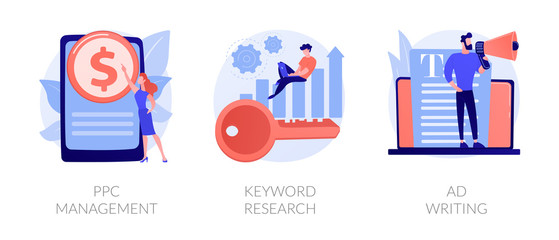
Now, let us look at some strategies you can use:
There are three keyword types:
Branded keywords refer to products sold by a specific company—for example, Nike shoes or Volkswagen Beetle.
Service or product-specific keywords that consumers use when they are interested in finding a particular product or service and don't care much about brand names. For example, leather couch or organic coffee.
High-intent keywords with a commercial nature such as designer clothing on sale.
Feature-specific keywords focus on key aspects of a product, service, or brand. Examples of these are "data lake" or "data warehouse."
Use tools like Spyfu or BuzzSumo to identify the keywords they are targeting, bidding on, and using in their content.
These tools can provide greater insight into how you can improve your keyword strategy, which includes access to the PPC keywords they are targeting, paying per click, and spending per month, as well as their ad position, and the search queries that trigger them.
Here is where SEO and PPC keyword research unite. Once you have a list of keywords you think your intended audience will use, verify that the search volumes for these words are worth investing.
Remember to look for keyword suggestions. There are endless ways to search for the same things – gather as many options as you can on this.
Once you upload your keyword list onto the Google Ads platform, identify their number of monthly searches or potential impressions, the estimated CTR, and the average CPC that you might expect to spend.
Other factors to consider are high search volume, low competition, and low-cost keywords as often as possible. Some of your most high-value keywords could cost more but are worth the price because they send more conversions or send you customers that buy more expensive products or services.
There is a reason using ad groups is a PPC best practice. With ad groups, your keywords are organized based on topics, products, or themes, which makes creating your ads a whole lot easier.
Dynamic keyword insertion (DKI) is a Google Ads feature that allows advertisers to customize their ads based on a user's search query. It will enable businesses to show users an ad that's more specific to their search. This way, they're more likely to click on it.
DKI works like this. Let's assume you have an ad group with the following keywords:
All of these keywords are related to an overall theme, which is digital marketing services for manufacturing companies.
The image below is a recreation of the form that advertisers use to create their search ads when they use platforms like Google Ads.

The ad below is the version that Internet users will see when your ad is displayed as a sponsored result.

When creating your ad, you will need to fill out these form fields. The keyword you want to insert dynamically is included in brackets and highlighted in yellow. This means that when someone searches for "digital marketing for manufacturing industry" and your ad places within the first few ad rankThe position assigned for an ad on a search results page. Because results pages display an average of two to four search ads, an ad ranked number ten will not be displayed at all., they will see this.
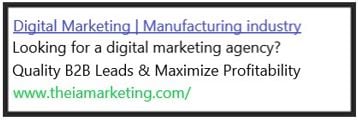
However, if the user searches for "online marketing for industries," they will see the same ad but with the search keyword that is replaced.
Targeting a set of words without considering keyword intentThe purpose behind a search query. can break what could otherwise be a solid PPC campaign.
By leveraging keyword intent, advertisers can increase website traffic, attract a higher number of qualified leads, and achieve more sales and higher revenue.
To understand a user's intention(s) behind a search, let's look at the three basic types of queries:
Every search conducted on every search engine will fall into one of these three categories.
Transactional searches are high intent keywords because they come with commercial intent. Examples of these include:
It is within the transactional searches that we can spot consumers who are near the end of the buyer's journey. Most of these individuals perform a transactional search because they have the intention of purchasing a product or service. If their search triggers any keywords your campaign is targeting, the chances of them clicking on your ad is high.
However, it is important to understand that not every ad will be displayed. For this to happen, you need to beat out other competitors on bid auctions.
Navigational searches are low intent keywords given their non-commercial nature. For this reason, these types of searches usually do not render great PPC results.
Examples of these include:
Informational searches get a little tricky when determining if they are worth spending money on. It comes down to determining the intent of the search, and they type of information that the searcher is looking for, if they are looking for information on or relating to something about general knowledge then there is not much value in paid advertising. However, if they are looking for information on solving a problem where a commercial solution is possible, then PPC is a valuable resource.
General knowledge informational searches are low intent keywords given their non-commercial nature. For this reason, these types of searches usually do not render great PPC results.
Examples of these include:
Problem-solving informational searches are medium intent keywords given that the search is looking for a way to solve a problem or a pain point. These types of searches can mean that the search is looking for a tool or method to solve their problem, but it does not mean they are willing to spend money on a solution yet.
Examples of these include:
Creating a PPC ad campaign that persuades others to click on your business’s ads and convert is not the easiest of tasks. However, knowing your conversion goals, the types of ad campaigns you want to run, and what you’re offering are all essentials for building a winning PPC strategy.
Establishing parameters for your PPC ad campaigns is an essential step toward concrete results. These parameters can range from your maximum bidA bid an advertiser sets to determine the highest amount of money they’re willing to pay for a click on their ad. amount to the geographical locations of the users you want your ad to appear to location-based marketingA marketing strategy that changes depending on a prospect’s geographical location and adapts to assumptions made of the social, cultural, and personal characteristics of someone based on their location..
Before investing in ad spend, marketing teams should have explicit knowledge of what they want to accomplish through ads. You can decide what your real objectives are by answering these questions for your business:
Brand awareness, brand recognition, brand identity, and brand recall are all the same thing. The goal is to make your brand as recognizable as possible for your target audience.
When they see your brand logo, brand name, or ad online, they should be able to identify who you are and what you sell. Raising brand awareness around the services you give is an excellent start to get prospects thinking about your company as a trusted source.
Site traffic measures the number of users who visit your website in one of three ways. 1) they directly went to your site by typing its URL in the address bar, 2) they performed a search query on Google and found your webpage among the top 10 search results, or 3) they conducted a search query, saw a search ad, clicked on it, and landed on your site.
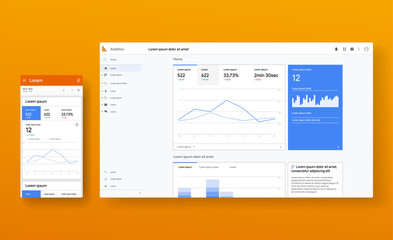
In PPC, website traffic measures the effectiveness of ad campaigns and the number of clicks an advertisement receives.
Lead generation aims to attract audiences through different channels, which can range from webinars, email newsletters, social media, and PPC ads. When a PPC ad campaign is successful in converting prospects – be it by subscribing to an email list, adding an item into the site’s shopping cart, or making a purchase – it can be considered successful.
Every PPC ad needs an offer promotion. It’s the hook that reels in new prospects. An offer promotion aims to educate and persuade users of the positive characteristics of a product or service so that they feel compelled to click on the ad.
There is no doubt about it: Pay-Per-Click ads aim to sell. When an ad campaign is successful, the advertiser will see an increase in the number of sales-qualified leads that need further assistance from the business’s sales department.
There are several types of PPC advertising to choose from:
A business can choose to invest in a combination of these. The types of advertising and investment put into each one will depend on various factors. Among these are:
We will look at how the following concepts can shape your research.
Search engine marketing is a strategy that aims to increase traffic and visibility on search engines through paid efforts.
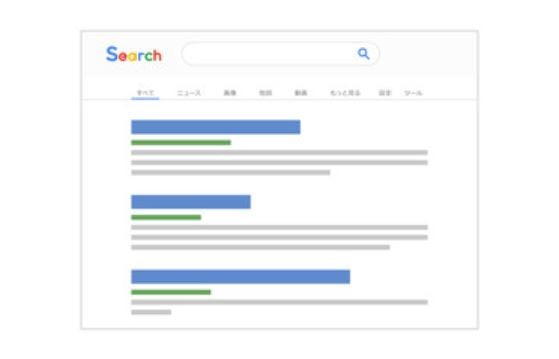
An advertising strategy that uses banner and video ads to improve online visibility and conversion rates.
Display advertising is a great way to put your product and company in front of potential customers, think about it like having a storefront with products in the window.
Social media advertising is the strategy of promoting brands on social networking channels.
Sequential advertising is a marketing tactic used to continue an advertising storyline. Ads are displayed in a predetermined order to match a prospect’s engagement journey with a brand.
Remarketing is an advertising strategy that targets individuals who have previously engaged with a business but didn’t buy.
Examples of engagement include visiting a company website, clicking on an ad, or browsing through a product catalog.
Every marketing team needs a clear understanding of the ad budget they have and how they need to distribute their funds, whom their ads are targeting, and what they will be focusing on them.
Without a clear understanding of your current position in the market and what you are looking to gain from ads, there is a high chance you could end up frustrated with your ad campaigns’ poor performance. Therefore, you must spend enough time understanding what you are trying to do so that you can avoid any possible pitfalls.
Keywords are a focal point for PPC advertising. Any keywords you choose to target in your ad campaigns should reflect the common search queries your target audience uses to find solutions to their problems.
Google Ads lets advertisers specify how they want their ads to match users’ keyword search queries. Instead of perfectly matching each keyword search, ads can appear if one or two of their chosen keywords are used.
There are five keyword match types: broad match, modified broad match, phrase match, exact match, and negative match.
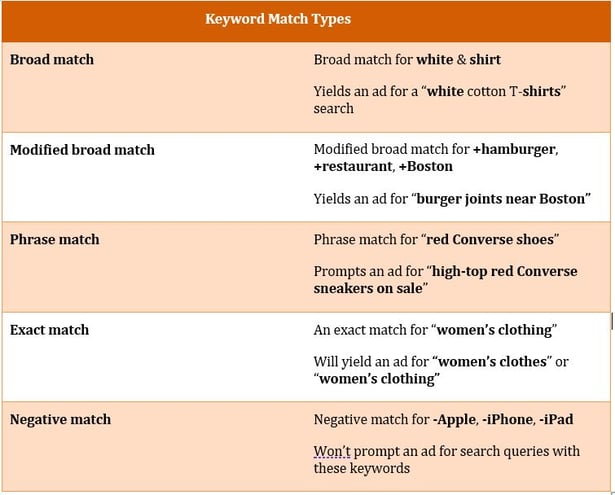
A broad match for the keywords white and shirt would mean that a user who searches for “white cotton T-shirts” would see the ad.
When creating this match type, each keyword is preceded by a +.
For example, using keywords like +hamburger, +restaurant, and +Boston with a modified broad match would yield a user who searches for burger joints near Boston to see your ad.
When creating this match type, include your keywords between quotation marks.
Employing keywords like “red Converse shoes” with a phrase match would yield a user who searches for high-top red Converse sneakers on sale to see your ad.
You can create this match type by adding brackets around your keywords.
Using the keywords [women’s clothing] will prompt your ad to appear only when a user searches for women’s clothes or women’s clothing.
This match is created by adding a minus sign to the chosen keywords.
For example, if your business repairs Windows and Android devices but not Apple products, using -Apple, -iPhone, or -iPad will indicate Google Ads not to show your ad(s) when a user uses any of these search terms.
Negative keywords keep your ad from showing up when they are used. For instance, a business that only sells organic juice would use “organic smoothies” as a negative keyword.
Your target audience is the people you want to sell your products or services to. They share common traits like interests or problems, which you can help address.
Your PPC ad campaigns should use the information on your target audience to reach out to more of them.
An ad campaign’s marketing budget will determine how long a campaign will last, how many ads will be displayed, and where the ads will be displayed. Before kicking off a campaign, make sure you have an overview of how to distribute funds appropriately.
Demographics play a crucial role in social media advertising. Businesses can choose the age range, gender, education level, and interests of their ads’ intended audience to earn better results.
The following metrics are essentials to evaluating the performance of your PPC ad campaigns.
A/B testing, commonly known as split testing, compares two versions of an ad against each other to determine which one performs better and gains higher conversion results.
When split testing an ad, consider tweaking the ad copy, CTA, and offer promotion. In the case of social media and display ads, switch up the images or videos, to see which ad receives greater engagement.
In PPC, each click on an ad translates into a fee the advertiser must pay. A click does not mean that a user will look at the website they are redirected to or that they will buy something. However, every click an ad receives is considered interaction with the advertisement.
When determining how successful an ad is, businesses need to know how many times the ad was displayed and compare it to the number of clicks it received.
A conversion rate measures the percentage of users who take the desired action.
A higher conversion rate means that an ad is successful at persuading users to click on it. At the same time, the webpage they are redirected to also does an excellent job of convincing them to carry out the requested activity.
Every ad campaign will determine its conversion goal; this can be anything from buying the item or service in promotion, setting up a meeting with a sales representative, or signing up to an email list. A business’s needs will determine the conversion goal at the time of planning the campaign.
To determine how successful an advertisement is, make sure to keep tabs on the ad’s conversion rate and cost per conversion.
PPC ads generate a fee every time they are clicked on.
To avoid paying for clicks that don’t lead to a conversion, make sure you A/B test different versions of an ad, target the right combination of keywords, and display your ads to the right audience.
After wrapping up an ad campaign, the gross margin percentage will determine the profit earned after subtracting the cost of all goods sold.
An ad’s CTR will determine the level of engagement your advertisement is receiving from users. Generally, a higher CTR is excellent. However, be sure that the number of clicks is proportionate to the number of conversions your ad is eliciting. If that’s not the case, then your ad may be attracting users who aren’t converting.

Impressions are the number of people who see your ad across all channels. When setting up your ads, be specific about the factors you want to trigger your ads to show.
Use keyword match types and adjust your ad preferences accordingly.
Determining your ad spend can be tricky, especially if you are new to PPC advertising. If you are just starting, it is essential to start slow.
Do not designate much ad spend to a campaign that you’re not sure how it will perform in the short and long term.
RAS is vital to measure the effectiveness of an online ad campaign. The more revenue your business earns for every dollar it spends on ads, the more successful it is.
Also known as Cost per Action (CPA), cost per conversion is important for managing an ad budget and deciding the best way to advertise.
For example, if the cost to acquire a new client is inexpensive, a campaign running on a tight budget may decide to target additional keywords or may want to publish their ad on a different social media platform.
If your business considers running search ads, keeping a good quality score should be a priority. Google Ads uses advertisers’ overall ad quality score, among other factors, to determine an ad’s rank order.
From businesses new to the world of PPC advertising to seasoned PPC professionals and everything in between, there are specific strategies every marketer should consider when creating a game plan fit for your business goals.
The beauty of SEM lies in that your ads show up at the moment a consumer is searching for something your ad can provide. Knowing what your audience would search for is essential; if you understand the words or phrases they use, you can build your ads around them.
To make search ads and Google Ads work for you and not against you, you must always consider the bidding system that will determine which ad displays for specific keywords.
In general, competitive keywords dictate the average maximum bid for a specific keyword.
If you are willing to bid on the more popular (and often general) keywords for your campaign, the odds may not be in your favor. You could spend a lot of money for highly competitive keywords that could bring in less qualified traffic – this is the last thing you want.
Your aim should be to attract as much qualified traffic to your website as possible, which increases the probability of a prospect converting into a customer. For this, a common route for businesses is to target keywords that relate to the products or services they offer.
For example, if your business manufactures plastic plates and cups and sells them to restaurants and party supply stores, make sure you target the specific keywords that can lead others to your site.
Keywords like “manufacturing plastic plates,” “manufacturing plastic cups,” “plastic plates and cups,” and “B2B plastic plates and cups” are all viable alternatives.
To ensure you choose the best keywords for your ads, investing some time in keyword researchThe process of searching for keywords relevant to your website and determining which ones can yield the highest ROI. is fundamental. Tools like Moz and Ahrefs can help you determine which keywords to targetThe process of matching keywords to what your customers may search for when looking for a product or service. based on their specificity to your organization, their competitiveness, and the average bid amount.
Once you have chosen the words to target, maintaining a keyword monitoringAn SEO strategy that helps marketing teams analyze metrics related to their chosen keywords. These metrics include keyword distribution, keyword competition, and keyword ranking. system can provide you insight into how well your website and landing pagesA single web page created specifically for a marketing or advertising campaign. Landing pages are where a user will “land” after they click on a link in an ad. rank for your chosen keywords.
Negative keywordsA type of keyword that prevents your ad from showing up when someone searches that phrase. prevent your ad from appearing after a search query.
It is a strategy that can improve the odds your ads are displayed only to those highly likely to be interested in buying your products or services.
By eliminating irrelevant traffic, you make sure you are not paying for clicks with very low probabilities of converting.
There are three stages of the buyer’s journey: the awareness, consideration, and decision stages.
Most consumers don’t buy during the awareness and consideration stages. They typically do their research to identify their pain points and consider their options.
When it comes to keyword targeting, most businesses choose keywords that fall within the awareness and consideration stages.
Search queries like best flat-screen TVs or TVs on sale are examples of what consumers in these stages are searching for. When they click on an ad for these searches, they tend to look through the product catalog and compare models and prices, but not likely to buy at that moment.
However, when a consumer is set on a specific tv they want to buy, in the decision stage, they will search for LG C9 OLED TV on sale or where to buy LG C9 OLED TV.
If you are a business looking to target consumers on all levels of the buyer’s journey, you’ll want to consider the many different ways a person would search for your products or services.
Speaking of strategically selecting the keywords that trigger your search and display ads, you also want to personalize them for greater reception.
Prospects only care about your ad conveying how it can help them solve an issue they have. Whether its cybersecurity software for their online business or in-home gym equipment with free shipping, they will click on your ad if it is in their interest.
For this reason, it is essential for you as a business to understand and communicate how you can provide what they want and need.
While this may seem like a no brainer to some, it’s worthy of mentioning it. At every point in time, you need to ensure your team is distributing your ad budget as efficiently as possible.
Reviewing and reevaluating your ad budget brings you one step closer to finding the right balance for you.
Are you investing in display advertising, but your conversion rates are lacking? Are your social media ads garnering higher engagements? Always keep an open mind to reallocating your resources for better and more significant results.
Ad groupsOne or more ads that share similar targets. Ad groups are used to organize your advertisements into different categories, such as themes or products/services or buyer personas. help organize advertisements into themes such as fast food, software, or travel destinations, as well as products and services.
When creating a campaign on Google Ads, ad groups make your job easier. In each group, you can include every related keyword, ad text, and landing page you have.
The key to making ad groups work is to make sure every component can interrelate. For instance, every keyword makes sense with every ad text and landing page it could be paired to.
This fact is important because search engines use ad groups to know:
Ad groups also give Google Ads the option to pick and choose which keywords, text, and landing pages would best fit a search query. Here lies the importance of creating small and focused groups.
A component of an effective PPC campaign includes a good user experience. When it comes to ads, the quality of landing pages shapes a prospect’s overall user experience.
If a landing page is poorly designed or contains irrelevant information, the advertiser will still need to pay a fee for the click that got the consumer to the landing page. However, the chances of this consumer converting will be very slim. It also affects your quality scoreA score of 1-10 that estimates the quality of your ads, keywords, and landing pages. It acts as a predictor of how effective your ads will be in converting prospects. Google Ads calculates this score., which predicts how successful your ads will be.
Ior this reason that every landing page featured on a PPC ad needs to be optimized with high-quality copy, targeted keywords, and a call-to-action.
A call to action does not need to be fancy; it just needs to be precise. What do you want the consumer to do? Is it to browse through your product catalog and make use of a discount offer? Do you want users to sign up for a newsletter or a free demo? Or is your aim for them to download a sneak peek of exclusive content?
Sample call to actions for businesses that sell products is “Shop now” or “Buy (product) now.” For service-based companies, “Get an instant quote online” and “See pricing” are great alternatives.
Whatever you ask in your call to action should be your conversion objective. Being clear about the steps that are considered conversions facilitates your marketing team’s ability to practice conversion trackingA strategy that oversees the actions prospects take to complete a specific goal such as signing up for an email newsletter or contacting a business. and calculate the cost per conversion for a campaign.
A/B testingA method of comparing two versions of a web page or app against each other to determine which one performs better. is a powerful tool to use if you want your target audience to respond favorably to advertisements from the get-go. It also helps you as a business, understand what works for your audience. Do specific CTA’s influence your audience more to convert? Are you using the most efficient ad copy to get users to click on an ad?
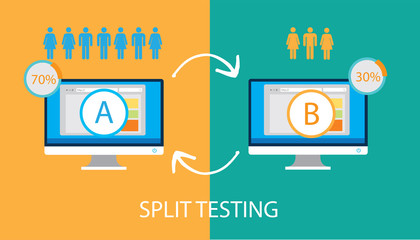
You can even try using the same landing page but with slightly different wording or using different ad extensionInformation found on a text ad such as location details, links to pages on your company site, and business phone number. It includes site link extensions. combinations.
A/B testing does not just apply to search ads; it applies to social media, display, and remarketing ads too. So start testing your ad campaigns against each other to gain data over time and a better understanding of your target audience’s behavior.
Learning and investing in PPC advertising is a big decision that should not be taken lightly.
Before taking the big step, it is essential to consider what your marketing objectives are, the resources you have at hand to make it happen and if it is possible to achieve them through PPC.
Individual businesses are likely to achieve greater success, ROAS, and ROI over others, which comes in large part to the nature of the relationships these business types have with customers.
It is important to remember that PPC ads work best when there is a commercial intent, that is, the ad is promoting a product or service. In such situations, consumers who click on PPC sponsored ads are 50% more likely to purchase when compared to those who click on an organic search result to look for products.
These businesses experience greater PPC success because once a commercial relationship is cultivated, it has the potential to generate income for a lifetime.
Any business that provides its clients with computer software, SAAS, and other subscription-based software can be sure they will generate revenue from their services.
Engineering and architecture firms have the potential to maintain their clientele over long periods.
There is a multitude of industries that fall within the umbrella of manufacturing.
Companies that produce electrical equipment, machinery, pharmaceutical products, furniture, and vehicles, among others, all have the potential to earn substantial profits from their clients in the long term.
When a health care provider sees a new patient, this patient can bring in thousands or tens of thousands of dollars in revenue over many years. This situation is especially true if the individual refers to other patients.
Community colleges, universities, and online programs like the University of Phoenix, ITT, and DeVry provide their students with educational programs that can last for years.
Most consumers hire one service provider for their phone, cable, and Internet services. They pay a cumulative monthly bill, typically for many years or a relatively long time. Any recurring service (subscription-based software, for example) could fit the same model.
Law firms have the potential to make huge profits off a single case.
Home repair services such as roof and indoor home repair services can be costly. If the service provider delivers at a reasonable price, they may have earned a client for a lifetime.
Consumers tend to compare prices between computer retailers in and around their location area. PPC advertising provides the perfect opportunity for this.
Car dealerships can also benefit that focus on relevant keywords, and location-specific PPC ads have much success.
PPC advertising can also work with businesses that:
Engineering and architecture firms, doctors, and home repair services – these are among the locally based businesses that have the greatest opportunity to thrive with PPC marketing.
For local businesses, optimizing their directory listings ensures they appear in search queries for someone actively searching for a solution nearby.
PPC advertising gives companies like your local car dealership and community college the opportunity to improve their audience outreach.
They also help businesses attract on-site visits, get calls, and help customers learn more about their business before setting foot in it.
Local search ads achieve this by targeting locally competitive keywords that will trigger their ads to appear. Comprehensive keyword research can help your team determine the best keywords for your PPC strategy.
An important thing to consider is that local pack ads also prompt businesses to pay per click, but there’s more to it. Companies using local pack ads pay a small fee every time their ad receives:
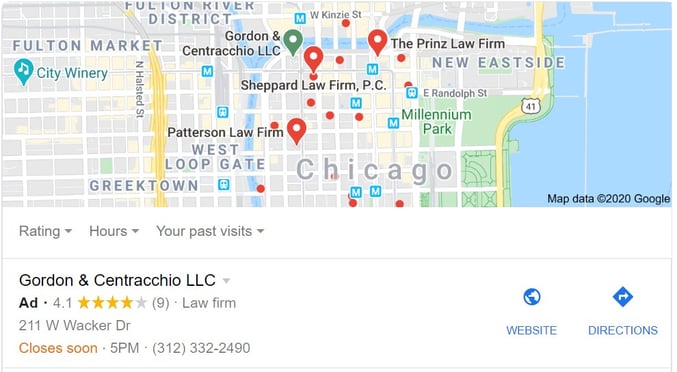
Knowing the different components that make up the fee an advertiser must pay is essential for choosing which keywords to target. The higher relevancy each keyword has to your business, the greater chances each click your ad receives must convert a consumer into a customer.